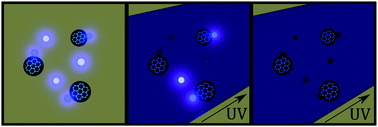UV photobleaching of carbon nanodots investigated by in situ optical methods†
Abstract
Carbon dots are a family of optically-active nanoparticles displaying a combination of useful properties that make them attractive for many applications in photonics and photochemistry. Despite the initial claims of high photostability of carbon dots even under prolonged illuminations, several recent studies have evidenced their photobleaching (PB) under UV light, detrimental for some applications. A study of the mechanism and dynamics of carbon dot PB can be considered a useful route to gather relevant information on the underlying photophysics of these nanoparticles, which is still widely debated. Here we report a study of the PB of carbon dots under UV light, conducted through optical experiments under well-controlled illumination conditions. In particular, the use of a laser as an irradiation source allows a precise control of the irradiated volume, and provides accurate estimates and control of the administered energy. Besides, our setup allows spectroscopic measurements to be carried out in situ at the irradiated site, thus allowing us to investigate in real time the progress of photobleaching effects through a time-resolved approach. Therefore, our experiments allow the precise kinetics of the undergoing PB process to be captured which is found to be significantly affected by disorder and photoselection effects. Furthermore, our study discloses several pieces of information on the nature of the main blue chromophore absorbing at 340 nm and emitting at 430 nm, and on its PB mechanism. We propose that the emissive units consist in small molecular-like chromophores adsorbed on carbon dot surfaces and are in a dynamical equilibrium with free diffusing molecules in solution. Their photobleaching proceeds in two distinct steps: in the first phase, linear absorption of UV photons rapidly converts the molecular surface chromophores into a non-emissive form, likely through an isomerization, causing the disappearance of the fluorescence properties but almost no changes in the optical absorption spectra. At higher fluences, a complete destruction of the optically-active centers is observed, which completely wipes out all the absorption features of surface chromophores and only leaves a fully carbonized, yet non-fluorescent, dot core.



 Please wait while we load your content...
Please wait while we load your content...